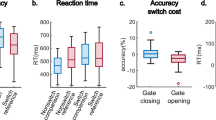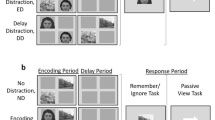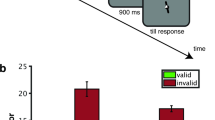Abstract
How does the brain maintain information in working memory while challenged by incoming distractions? Using functional magnetic resonance imaging (fMRI), we measured human brain activity during the memory delay of a spatial working memory task with distraction. We found that, in the prefrontal cortex (PFC), the magnitude of activity sustained throughout the memory delay was significantly higher on correct trials than it was on error trials. By contrast, the magnitude of sustained activity in posterior areas did not differ between correct and error trials. The correlation of activity between posterior areas was, however, associated with correct memory performance after distraction. On the basis of these findings, we propose that memory representations gain resistance against distraction during a period of active maintenance within working memory. This may be mediated by interactions between prefrontal and posterior areas.
This is a preview of subscription content, access via your institution
Access options
Subscribe to this journal
Receive 12 print issues and online access
$209.00 per year
only $17.42 per issue
Buy this article
- Purchase on Springer Link
- Instant access to full article PDF
Prices may be subject to local taxes which are calculated during checkout





Similar content being viewed by others
References
D'Esposito, M. & Postle, B. R. The dependence of span and delayed-response performance on prefrontal cortex. Neuropsychologia 37, 1303–1315 (1999).
Miller, E. K., Erickson, C. A. & Desimone, R. Neural mechanisms of visual working memory in prefrontal cortex of the macaque. J. Neurosci. 16, 5154–5167 (1996).
Fuster, J. M. Unit activity in prefrontal cortex during delayed-response performance: neuronal correlates of transient memory. J. Neurophysiol. 36, 61–78 (1973).
Funahashi, S., Bruce, C. J. & Goldman-Rakic, P. S. Mnemonic coding of visual space in the monkey's dorsolateral prefrontal cortex. J. Neurophysiol. 61, 331–349 (1989).
Chafee, M. V. & Goldman-Rakic, P. S. Matching patterns of activity in primate prefrontal area 8a and parietal area 7ip neurons during a spatial working memory task. J. Neurophysiol. 79, 2919–2940 (1998).
Sawaguchi, T. & Yamane, I. Properties of delay-period neuronal activity in the monkey dorsolateral prefrontal cortex during a spatial delayed matching-to-sample task. J. Neurophysiol. 82, 2070–2080 (1999).
Miller, E. K., Li, L. & Desimone, R. Activity of neurons in anterior inferior temporal cortex during a short-term memory task. J. Neurophysiol. 13, 1460–1478 (1993).
Constantinidis, C. & Steinmetz, M. A. Neuronal activity in posterior parietal area 7a during the delay periods of a spatial memory task. J. Neurophysiol. 76, 1352–1355 (1996).
Compte, A., Brunel, N., Goldman-Rakic, P.S. & Wang, X. J. Synaptic mechanisms and network dynamics underlying spatial working memory in a cortical network model. Cereb. Cortex 10, 910–923 (2000).
Smyth, M. M. Interference with rehearsal in spatial working memory in the absence of eye movements. Q. J. Exp. Psychol. A 49, 940–949 (1996).
Awh, E. & Jonides, J. Overlapping mechanisms of attention and spatial working memory. Trends Cogn. Sci. 5, 119–126 (2001).
Rajkowska, G. & Goldman-Rakic, P. S. Cytoarchitectonic definition of prefrontal areas in the normal human cortex: variability in locations of areas 9 and 46 and relationship to the Talairach coordinate system. Cereb. Cortex 5, 323–337 (1995).
Kojima, S. & Goldman-Rakic, P. S. Delay-related activity of prefrontal neurons in rhesus monkeys performing delayed response. Brain Res. 248, 43–49 (1982).
Funahashi, S., Inoue, M. & Kubota, K. Delay-period activity in the primate prefrontal cortex encoding multiple spatial positions and their order of presentation. Behav. Brain Res. 84, 203–223 (1997).
Petrides, M. & Pandya, D. N. Projections to the frontal cortex from the posterior parietal region in the rhesus monkey. J. Comp. Neurol. 228, 105–116 (1984).
Cavada, C. & Goldman-Rakic, P. S. Posterior parietal cortex in rhesus monkey: II. Evidence for segregated corticocortical networks linking sensory and limbic areas with the frontal lobe. J. Comp. Neurol. 287, 422–445 (1989).
Miller, E. K. & Cohen, J. D. An integrative theory of prefrontal cortex function. Annu. Rev. Neurosci. 24, 167–202 (2001).
Chao, L. L. & Knight, R. T. Human prefrontal lesions increase distractibility to irrelevant sensory inputs. Neuroreport 6, 1605–1610 (1995).
Guillery, R. W., Feig, S. L., & Lozsadi, D. A. Paying attention to the thalamic reticular nucleus. Trends Neurosci. 21, 28–32 (1998).
D'Esposito, M., Postle, B. R., Jonides, J. & Smith, E. E. The neural substrate and temporal dynamic of interference effects in working memory as revealed by event-related functional MRI. Proc. Natl. Acad. Sci. USA 96, 7514–7519 (1999).
Bunge, S. A., Ochsner, K. N., Desmond, J. E., Glover, G. H. & Gabrieli, J. D. E. Prefrontal regions involved in keeping information in and out of mind. Brain 124, 2074–2086 (2001).
Rogers, R. D. & Monsell, S. Costs of a predictable switch between simple cognitive tasks. J. Exp. Psychol. Gen. 124, 207–231 (1995).
Gopher, D., Armony, L. & Greenshpan, Y. Switching tasks and attention policies. J. Exp. Psychol. Gen. 129, 308–339 (2000).
Rubinstein, J. S., Meyer, D. E. & Evans, J. E. Executive control of cognitive processes in task switching. J. Exp. Psychol. Hum. Percept. Perform. 27, 763–797 (2001).
D'Esposito, M. et al. The neural basis of the central executive system of working memory. Nature 378, 279–281 (1995).
Sohn, M-H., Ursu, S., Anderson, J. R., Stenger, V. A. & Carter, C. S. The role of prefrontal cortex and posterior parietal cortex in task switching. Proc. Natl. Acad. Sci. USA 97, 13448–13453 (2000).
Rowe, J. B., Toni, I., Josephs, O., Frackowiak, R. S. J. & Passingham, R. E. The prefrontal cortex: response selection or maintenance within working memory? Science 288, 1656–1660 (2000).
Rowe, J. B. & Passingham, R. E. Working memory for location and time: activity in prefrontal area 46 relates to selection rather than maintenance in memory. Neuroimage 14, 77–86 (2001).
Malmo, R. B. Interference factors in delayed response in monkeys after removal of frontal lobes. J. Neurophysiol. 5, 295–308 (1942).
Brewer, J. B., Zhao, Z., Desmond, J. E., Glover, G. H. & Gabrieli, J. D. E. Making memories: brain activity that predicts how well visual experience will be remembered. Science 281, 1185–1187 (1998).
Wagner, A. D. et al. Building memories: remembering and forgetting of verbal experiences as predicted by brain activity. Science 281, 1188–1191 (1998).
Courtney, S. M., Petit, L., Maisog, J. M., Ungerleider, L. G. & Haxby, J. V. An area specialized for spatial working memory in human frontal cortex. Science 279, 1347–1351 (1998).
Rosen, A. C. et al. Neural basis of endogenous and exogenous spatial orienting: a functional MRI study. J. Cognit. Neurosci. 11, 135–152 (1999).
Corbetta, M., Kincade, J. M., Ollinger, J. M., McAvoy, M. P. & Shulman, G. L. Voluntary orienting is dissociated from target detection in human posterior parietal cortex. Nat. Neurosci. 3, 292–297 (2000).
Perry, R. J. & Zeki, S. The neurology of saccades and covert shifts in spatial attention. An event-related fMRI study. Brain 123, 2273–2288 (2000).
Salinas, E. & Sejnowski, T. Correlated neuronal activity and the flow of neural information. Nat. Rev. Neurosci. 2, 539–550 (2001).
Varela, F., Lachaux, J. -P., Rodriguez, E. & Martinerie, J. The brainweb: phase synchronization and large-scale integration. Nat. Rev. Neurosci. 2, 229–239 (2001).
Frith, C. in Control of Cognitive Processes: Attention and Performance XVIII (eds. Monsell, S. & Driver, J.) 549–565 (MIT Press, Cambridge, Massachusetts, 2000).
Miyashita, Y. & Hayashi, T. Neural representation of visual objects: encoding and top-down activation. Curr. Opin. Neurobiol. 10, 187–194 (2000).
Wang, X. J. Synaptic reverberation underlying mnemonic persistent activity. Trends Neurosci. 24, 455–463 (2001).
Wagner, A. D., Maril, A., Bjork, R. A. & Schacter, D. L. Prefrontal contributions to executive control: fMRI evidence for functional distinctions within lateral prefrontal cortex. Neuroimage 14, 1337–1347 (2001).
Petrides, M. in The Prefrontal Cortex (eds. Roberts, A. C., Robins T. W. & Weiskrantz, L.) 103–116 (Oxford Univ. Press, Oxford, UK, 1998).
Owen, A. M. et al. Redefining the functional organization of working memory processes within human lateral prefrontal cortex. Eur. J. Neurosci. 11, 567–574 (1999).
D'Esposito, M., Postle, B. R., Ballard, D. & Lease, J. Maintenance versus manipulation of information held in working memory: an event-related fMRI study. Brain Cogn. 41, 66–86 (1999).
Engel, A. K., Fries, P. & Singer, W. Dynamic predictions: oscillations and synchrony in top-down processing. Nat. Rev. Neurosci. 2, 704–716 (2001).
Kato, M. et al. Eye movements in monkeys with local dopamine depletion in the caudate nucleus. I. Deficits in spontaneous saccades. J. Neurosci. 15, 912–927 (1995).
Acknowledgements
We are grateful to C. Frith, M. Rugg and R. Frackowiak for comments. This study was supported by the Wellcome Trust. K.S. was supported by the Human Frontier Science Program.
Author information
Authors and Affiliations
Corresponding author
Ethics declarations
Competing interests
The authors declare no competing financial interests.
Rights and permissions
About this article
Cite this article
Sakai, K., Rowe, J. & Passingham, R. Active maintenance in prefrontal area 46 creates distractor-resistant memory. Nat Neurosci 5, 479–484 (2002). https://doi.org/10.1038/nn846
Received:
Accepted:
Published:
Issue Date:
DOI: https://doi.org/10.1038/nn846
This article is cited by
-
Cognition-enhancing and cognition-impairing doses of psychostimulants exert opposing actions on frontostriatal neural coding of delay in working memory
Neuropsychopharmacology (2023)
-
Mechanisms underlying dorsolateral prefrontal cortex contributions to cognitive dysfunction in schizophrenia
Neuropsychopharmacology (2022)
-
The role of prefrontal cortex in cognitive control and executive function
Neuropsychopharmacology (2022)
-
Closing the gate to distractors during decision-making
Nature Neuroscience (2021)
-
Post-stimulatory activity in primate auditory cortex evoked by sensory stimulation during passive listening
Scientific Reports (2020)



